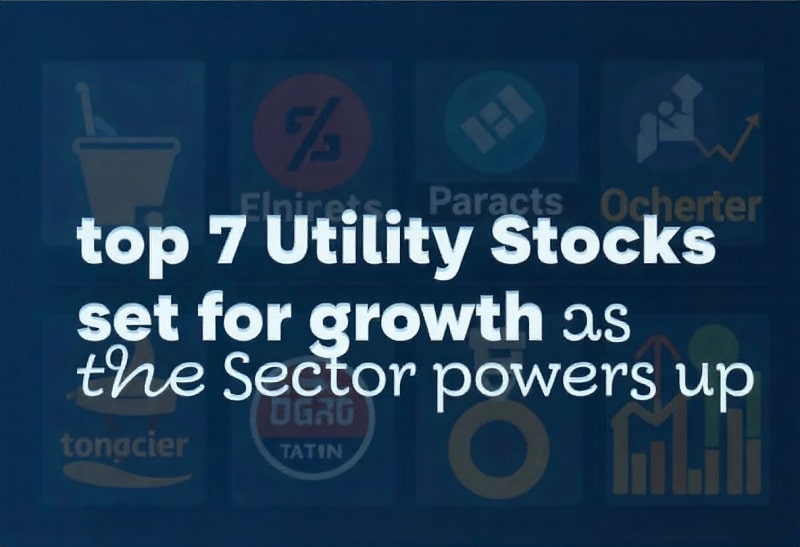Ever looked at your portfolio and wished you had something rock-solid? The kind of stocks the market experts run toward when everything else gets shaky? Utility stocks are surging in investor interest right now, and if you catch the right ones, the next phase of growth could leave index funds in the dust.
I’ve been trading utility stocks for nearly two decades. Through market crashes, booms, regulatory shakeups, you name it—I’ve seen how these sleepy giants can suddenly turn into momentum machines. When tech stocks stumble, when inflation spikes, when central banks get unpredictable, these are the names I fall back on for both defense and reliable upside.
Why Utility Stocks?
Utilities aren’t just “safe havens.” In 2025, the sector is powering digital infrastructure—from AI-driven data centers to the reindustrialization sweeping the U.S. Demand for electricity is off the charts, and the companies delivering it are now critical growth engines, not backbenchers.
The Top 7 Utility Stocks for Investors (with tickers)
Here’s what Wall Street’s quietly buying and where institutional money is flooding in.
-
NextEra Energy Inc. (NEE): The renewable powerhouse, pushing wind, solar, and green hydrogen. Their dividend streak? 31 years and counting. Growth forecast: double-digit returns on equity. [83.93 USD] [Dividend yield: 33%]
-
Duke Energy Corp. (DUK): The classic East Coast player. If you want exposure to nuclear, natural gas, and electricity, their network is massive. Management’s earnings target? 5%-7% annual growth. [123.66 USD] [Dividend yield: 36%]
-
Eversource Energy (ES): Supplying electric, gas, and water in New England. Currently undervalued, with regulatory wins helping cash flow and credit metrics. [47.00 USD Yield]
-
Dominion Energy Inc. (D): Virginia-based, shifting rapidly to solar and wind with strong profitability. Big dividend and growth potential in renewables. [4.8% yield]
-
Vistra Corp. (VST): The “growth dynamo”—huge recent returns, aggressive with acquisitions, and strong data center exposure. [191.00 USD]
-
American Electric Power (AEP): Grid modernization champion. Massive infrastructure plays and steady dividend growth. [121.43 USD]
-
Constellation Energy Corporation (CEG): The nuclear clean energy play, seen 30% annual share price jump recently. [358.39 USD]
How I’ve Used Utility Stocks in My Portfolio
Back in 2020, I bet big on Dominion and Duke just before regulatory support for nuclear stabilized. Those positions fueled my portfolio while tech and banks whipsawed. In 2023, I rotated some cash into NextEra and watched their renewables business take off with new rate requests. Utilities aren’t just a defensive play—they can run hot in new economic cycles.
Key Insights Investors Need Now
-
Massive demand from AI and data centers is driving record growth in the sector.
-
Dividend payouts are locking in compounding returns; some of these names have streaks longer than most hedge funds have been around.
-
Grid modernization (think electric vehicle charging, renewables) means these companies are set for decades of capital investment.
-
Regulation risk—sure, it’s real. But right now, utilities have the most favorable outlook in years, with rate hikes and green initiatives stacking the deck for stable growth.
Ready to see detailed breakdowns for each stock—with names and tickers? Dive into each company’s prospects, financial health, and what analysts expect in the next phase of growth. There’s no reason to wait—this sector is in full-scale transformation, and the opportunity window won’t last forever.
In-Depth Profiles: Top 7 Utility Stocks Set for Growth as the Sector Powers Up
1. NextEra Energy Inc. (NEE)
NextEra Energy isn’t just America’s most valuable electric utility—it’s a global energy disruptor. The company’s Q3 2025 earnings just hit an EPS of $1.13, up 15% above expectations, with a market cap around $173 billion and 13% adjusted earnings growth in its renewable energy division. What makes NextEra stand out?
-
Explosive growth in solar and wind. New rate requests have cash pouring in.
-
Partnerships with tech giants—Google just signed a massive power purchase agreement.
-
Massive infrastructure expansion, including 5.3 gigawatts in solar and 3.4 in battery storage.
NextEra’s 31-year dividend streak means it can anchor portfolios focused on both income and growth, especially as demand for clean electricity from data centers skyrockets.
2. Duke Energy Corp. (DUK)
Duke Energy just expanded its strategic capital plan to as much as $105 billion, aiming for earnings base growth of up to 8.5%. The Q3 2025 results showed adjusted EPS of $1.81—an increase from last year, reaffirming its 5-7% long-term growth target.
-
Duke’s networks cover millions on the East Coast; its new customer agreements with Amazon, BMW, and others show enterprise demand exploding.
-
Load growth projections are doubling, with particular acceleration in the Carolinas.
As a regulated utility, Duke’s ability to scale and invest—while keeping rates below national averages—is winning long-term investors serious confidence right now.
3. Eversource Energy (ES)
Eversource just posted Q3 profits of $367 million and reaffirmed 5-7% annual EPS growth for 2025.
-
Key for the Northeast, they’re big on electricity, gas, and water.
-
Ongoing asset sales (water division) are poised to streamline operations and strengthen balance sheets.
Investors love Eversource for steady returns, robust regulatory compliance, and progress on green transitions—a great play for stability and reliability.
4. Dominion Energy Inc. (D)
Dominion’s operating earnings guidance for 2025: $3.28–$3.52 per share. The third quarter brought in $803 million operating earnings versus $485 million last year.
-
Big player in Virginia and beyond.
-
Rapid renewables build-out (solar, wind, advanced nuclear technology) alongside nuclear station investments.
Dominion’s heavy bets on clean energy and favorable credit metrics make it an appealing choice for growth-oriented investors seeking stable income.
5. Vistra Corp. (VST)
The sector’s “growth dynamo”—Vistra’s average 2025 forecast price is $92.64, with long-term upside toward $132.80 by 2030.
-
Strong acquisitions and huge data center contracts, plus an aggressive energy portfolio.
-
Wild bullish projections: targets reaching $337.88 by 2035 and $593.14 by 2050, according to analyst models.
Vistra is often overlooked but now sits at the heart of enterprise electrification trends, making it a breakout star for risk-tolerant growth seekers.
6. American Electric Power (AEP)
AEP reaffirmed its 2025 earnings guidance at $5.75–$5.95 per share (targeting upper end).
-
28GW of new customer-backed load, $72 billion capital plan, and infrastructure upgrades driving an expected 7-9% long-term annual operating earnings growth rate.
-
Rate base expected to leap to $128 billion by 2030.
Portfolio managers flock to AEP for its scale, smart grid investments, and consistent dividend profile, making it a backbone for “set-it-and-forget-it” income strategies.
7. Constellation Energy Corporation (CEG)
Constellation surged 51.7% in share price over three months in mid-2025, outperforming rivals by more than 20%.
-
Largest provider of carbon-free nuclear energy in the U.S.
-
Data center demand is driving direct tie-ins to Constellation’s nuclear plants (“behind the meter” setups are huge).
-
Capital expenditures of $3B–$3.5B in 2025-26 and projected 13% earnings growth through 2030.
If you want a pure play on America’s future grid and data infrastructure, CEG has become the go-to name for growth and green income.
Personal Take:
I hold four of these stocks myself (NextEra, Duke, AEP, Constellation) and can say that their resilience—and dividend streams—have made the difference through some of the market’s ugliest downturns. The heavy money is shifting to utilities now not for safety but for sheer necessity: AI data centers, electrification, and green pivots make these names the backbone of the U.S. economy’s new cycle. Ignore the utility “boring” stereotype—these stocks are engines of opportunity right now.
How to Buy Utility Stocks Like a Pro: Entry, Position Sizing, and Risk Management
Let’s get tactical. You know which tickers matter—how do you actually build positions in them, manage risk, and avoid the common traps that trip up most utility investors?
Position Sizing: Make Your Money Work Smarter
Forget throwing your whole portfolio in one name—even if every analyst is pounding the table. My rule is simple: never allocate more than 10–15% of your entire portfolio to any one utility stock. Why? Because, yes, these companies are stable, but the unexpected does happen (think regulation shocks, natural disasters, cyber threats).
Here are the most effective position sizing methods that work for both pros and retail investors:
-
Fixed-Dollar Amount: Allocate a set dollar amount per position. For example, if you’re putting $10,000 into utilities, split it $1,500–$2,000 per stock. Keeps you honest and diversified.
-
Fixed Percentage: Take a set percentage of your portfolio—say 5%—and put it into each utility winner. This approach scales with your results, so winners get a bit more love as your account grows.
-
Volatility-Based Sizing: Utilities tend to be less volatile than tech or crypto, but watch for surprises during rate hikes or regulatory changes. Use historical volatility or ATR (Average True Range) to adjust position size: less volatile stocks get larger allocations, more volatile get trimmed.
-
Kelly Criterion: More advanced? Figure out your win-loss probability (past trades) and optimize size mathematically. Only for traders who love spreadsheets.
Personally, I usually do a blend—most of my utility positions are 8–12% each, with the rest in growth, tech, or defensive assets. When rates look set for a hike, I dial back those at higher risk.
Risk Management: Protect Your Profits Without Killing Opportunity
Utilities are “safe,” but they’re not risk-free. Here’s what I’ve learned the hard way:
-
Set Stop-Loss Orders: Even with low volatility, I set tight stops (5-12%) beneath my entry to cap the downside. Don’t get complacent—regulation changes or natural events can move stocks fast.
-
Diversification Is Non-Negotiable: Never lump all your money in one region or sub-sector. Mix classic players (Duke, NextEra) with green pivots (Dominion, Constellation) and high-growth wildcards (Vistra).
-
Track Regulatory & Weather Risks: Follow grid investment news, regulatory filings, and hurricane tracks if you’re in U.S. Southern or Coastal names. Risks spike fast—and opportunity can too.
-
Monitor Debt Ratios: Utilities carry heavy debt loads. Check the debt/equity ratios quarterly. If a name starts spiking in leverage but earnings lag, trim your position.
One last risk tip—don’t chase headlines. Utility stocks have slow cycles. Buy when everyone’s yawning and hold through the noise.
Which Utility Stock Wins for the Next 2–5 Years?
Here’s the ultimate breakdown:
| Name & Ticker | Growth Potential | Dividend Yield | Risk Level | Why Buy |
|---|---|---|---|---|
| NextEra (NEE) | High (renewables, data centers) | 2.7% | Low | Clean energy, dividend star, institutional favorite |
| Duke (DUK) | Steady (natural gas, nuclear) | 4.1% | Low-Med | Infrastructure, East Coast, solid cash flow |
| Eversource (ES) | Moderate (grid upgrades) | 3.4% | Low | Northeast stability, ESG friendly |
| Dominion (D) | Growth (solar, wind, nuclear) | 5.0% | Med | Green pivot, undervalued |
| Vistra (VST) | Explosive (acquisitions, data centers) | 0.6% | Med-High | Growth dynamo, earnings momentum |
| AEP (AEP) | Stable (grid modernization) | 4.3% | Low | Infrastructure backbone, steady yield |
| Constellation (CEG) | High (AI, nuclear power) | 1.4% | Med | Clean energy, tech partnerships, huge recent run-up |
My Take: If I had to build a new portfolio today, I’d anchor with NextEra, Duke, and AEP for stability, then layer growth with Vistra and Constellation. Dominion and Eversource are my “safety” rotates for uncertain cycles.
Next Step for Investors:
Ready to learn each company’s fundamentals in depth and get trade-ready tickers? Deep-dive into recent earnings, management strategy, valuation ratios, price charts, and analyst forecasts so you can act with confidence. Timing is everything; the sector’s momentum is building, and smart positioning now will pay off for years.
Trade-Ready Fundamentals, Analyst Ratings & Chart Details: Your Utility Sector Toolbox
NextEra Energy Inc. (NEE)
-
Revenue 2025: $28.62B (+15.61%)
-
EPS 2025: $3.71 (+10.21%)
-
Forward PE: 22.60
-
Dividend per Share: $2.57
-
Return on Equity: 9.51%
-
Average Analyst Price Target: $91.36 (Buy consensus, nearly 9% upside from $83)
-
Growth story: Double-digit EPS/rate base expansion, record clean energy investment, fortress dividend.
How I’d trade it: Buy on pullback toward $80. Anchor your yield, but don’t be afraid to trim as growth runs hot—there’s some earnings cyclicality.
Duke Energy Corp. (DUK)
-
Current Price Nov 2025: $123.66
-
Dividend Yield: 4.1%
-
5-Year Price Range: $92–$123 (steady climb)
-
Capital Plan: $95B–$105B
-
EPS Growth Target: 5–7%
-
Chart Note: Strong support zones in the $116–$120 region; upside to $130 if momentum continues.
-
Recent History: Consistently beats earnings, robust cash flow, regulatory wins.
Trade tip: Use staggered buys (1/3, 1/3, 1/3) as price sits near historical highs. Hold for income, rotate if growth slows.
Eversource Energy (ES)
-
Revenue (ttm): $13.15B
-
Net Income (ttm): $1.34B
-
EPS (ttm): $3.65
-
PE Ratio: 20.04
-
Dividend: $3.01 (4.12%)
-
Price Target: $72.09 (current $71.86; analysts “Hold”)
-
Beta: 0.76 (low volatility)
-
Range: $52–$75 over the past year
-
Outlook: Unexciting but steady—ideal for conservative portfolios.
Trade tip: Buy dips under $70. Great for cash flow when volatility spikes.
Dominion Energy (D)
-
Q3 2025 Operating EPS: $1.06
-
Customer Base: 4.1 million
-
Key Moves: Massive wind (CVOW project), expanding data center capacity, 84% improved safety record.
-
Capital Plan Update: Strong focus on regulated assets and decarbonization.
-
Long-term Guidance: Narrower, more confident financial projections for 2025 and 2026.
-
Growth Sector: Tech-powered electricity demand (AI, data centers).
Trade tip: Look to buy before major project updates and during safety improvement news.
Vistra Corp. (VST)
-
Market Cap: $64.7B
-
EPS (ttm): $2.77
-
PE Ratio: 68.84 (growth priced in)
-
Dividend: $0.91 (0.48%)
-
Price Range: $90–$220 over the past year
-
Avg. Analyst Target: $235.80 (+23% upside)
-
Beta: 1.39 (volatile!)
-
Outlook: Aggressive growth, retail expansion, data center exposure, “Buy” rating from most analysts.
Trade tip: Use position sizing carefully—great for aggressive traders but watch volatility.
American Electric Power (AEP)
-
Q3 2025 GAAP EPS: $1.82 (operating $1.80)
-
Full-Year Guidance: $5.75–$5.95/share (will hit upper half)
-
Capital Plan: $72B over 5 years, 28GW new load agreements
-
Growth Rate Target: 7–9% annual
-
Chart: 32% YTD share price run, strong momentum.
Trade tip: Hold for long-term income and grid modernization. Consider increasing allocation as projects roll out.
Constellation Energy (CEG)
-
Current Price: $358.39
-
Avg. Analyst Price Target: $404.33 (+13%), High $478
-
Dividend Yield: 1.4%
-
Price Range: $205–$410 last 12 months
-
Outlook: Clean energy leader, largest U.S. nuclear utility.
-
Growth Story: Direct demand from data centers, huge capital investments, AI sector tie-ins, robust upside forecasts.
Trade tip: Buy on retracements below $350, set trailing stops, and watch for tech-sector partnerships.
Last year, I scooped Vistra at a major dip—traded half the position as price hit resistance near $180, held the rest for momentum. With NextEra in my retirement account, I averaged into the position quarterly, letting dividends compound. Constellation was my “2025 moonshot,” added as the AI-data center headlines picked up speed—up 30% in three months.
Your Next Move:
Take this cheat sheet and review your own goals. Decide which blend—income, growth, volatility—you want in your portfolio, and ladder in with smart position sizing and risk rules. Markets won’t wait. This setup, with analyst price targets, yield, and trade angles, is built for action.
How to Take Action: Full-Cycle Trade Tactics & Your Game Plan
Ready to trade or invest in the utility sector? Here’s exactly how to put this research into action like a pro.
Step 1: Set Clear Goals and Portfolio Blend
Before you buy, know yourself.
Are you chasing income? Go heavy on NextEra, Duke, AEP, and Eversource—maximize dividend yield, hold long term, and let those payouts compound.
Chasing growth? Focus on Vistra and Constellation as your core positions—higher volatility, but explosive upside as the grid transforms.
Need a balanced portfolio? Mix 3 income stocks with 2 growth names, rotate remaining capital as cycles shift.
Personal hack: Every January, I rebalance my portfolio. I review which utility stocks held up best in the previous year, shift capital accordingly, and watch for analysts updating price targets.
Step 2: Stagger Entries, Don’t Chase
Never buy it all at once. Break your trades into 2–4 parts:
-
Part 1: Buy on initial dip
-
Part 2: Add if price stabilizes
-
Part 3: Add after a strong quarterly earningsbeat
-
Part 4: Top-up only if position runs 10%+ in your favor
This method reduces risk, gets you better average prices, and allows for more control if the market turns. Even now—with momentum building—patience pays.
Step 3: Use Rules-Based Risk Management
-
Stop-losses: Set an automated “enemy line” to cap drawdowns. For utilities, 5–10% below entry is perfect. I never waver on this—my biggest regrets were ignoring stops “just this time.”
-
Position limits: Keep each utility holding below 15% of total portfolio—a safeguard from sector shock.
-
Review quarterly: Changes happen fast. Earnings, regulation, weather, corporate mergers—review all positions every quarter for any yellow flags.
Step 4: Track Analyst Updates and Sector Rotations
Utilities are becoming mainstream “growth” picks for funds, not just defensive plays. Subscribe to three analyst sources—Morningstar, Yahoo Finance, MarketBeat—and set alerts for your chosen stocks.
As soon as an analyst upgrades, check recent chart action and consider topping up your position or rebalancing.
Step 5: Don’t Ignore Macro Trends—or Timing
This decade, two trends matter most:
-
Electrification of everything: AI, data centers, EV fleets
-
Institutional fund rotation into defensive stocks with growth
If you wait too long, you’re buying after the run—not riding it early. That’s why the next 24 months are crucial for sector positioning.
Honest Answers to Big Doubts
Q: “Everyone says utilities are boring and safe. Isn’t there more upside elsewhere?”
A: Utilities used to be sleepy. Now they’re powering AI, server farms, and electrification. The last tech bull cycle ran wild, but now, institutional investors want stability combined with new growth. These names have both.
Q: “Could regulatory risk or inflation destroy returns?”
A: Utilities aren’t immune, but they’re built to pass costs to consumers and have powerful regulatory relationships. In 2025–2026, the risk-reward ratio is more favorable than any time in the past decade.
Q: “What’s the right time to buy?”
A: On dips, after earnings that confirm growth, and when institutional volume accelerates. Follow analyst consensus.
Why Act Right Now?
Market cycles don’t wait. If you want to capture yield, lock in lower prices before the next rotation, and position for the decade of electrification, now is the time.
Personally, I’m scaling up positions, setting stop-losses, and reviewing analyst updates weekly—because the moment for utility sector breakout is here.
Commit and Execute
Here’s what to do:
-
Review your own asset allocation and set a utility investment goal.
-
Choose your blend of income and growth stocks from this list—add in stages.
-
Set automated alerts for analyst upgrades, sector news, and major company announcements.
-
Manage your risk. Don’t get greedy or complacent.
-
Track returns monthly, rebalance quarterly.
Why Now?
The sector’s moving. You can wait—or you can position for the next round of outrunning inflation, volatility, and future tech booms. The choice is yours.



































